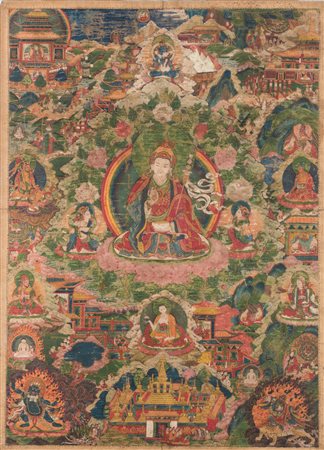 Capitolium Art - Via Carlo Cattaneo 55, 25121 Brescia
Capitolium Art - Via Carlo Cattaneo 55, 25121 Brescia
ASTA 217 - FINE CHINESE, ISLAMIC & ASIAN ART 2A TORNATA
giovedì 15 giugno 2017 ore 14:00 (UTC +01:00)
Arte Himalayana Thangka raffigurante Padmasambava Tibet, XVIII secolo . -. Cm...
Arte Himalayana Thangka raffigurante Padmasambava
Tibet, XVIII secolo . -. Cm 51,00 x 67,00. Importante pittura su cotone a pigmenti naturali raffigurante il maestro Padmasmbhava (Guru Rimpoche), colui che ha introdotto il buddhismo in Tibet. Ritratto centralmente nel suo principale e storico aspetto, é abbigliato con sontuose vesti monacali rifinite in oro e porta nella mano sinistra, adagiata in grembo, una Kapala, e nella destra un vajra. Poggiata ad una spalla é presente la bacchetta magica khatvanga, che lo distingue come detentore di poteri magici. Mostra inoltre grandi orecchini ed un copricapo di foggia esclusiva. Seduto in posizione padmasana su una base decorata da petali rosati é attorniato da una aureola arcobaleno e da boccioli e foglie di peonia, le quali avvolgono ai suoi lati le sue due mogli in posizione orante: Mandarava a sinistra e Yeshe Tsogyal a destra.
Intorno al maestro, in una rara composizione, sono raffigurate, inserite in un ambientazione arborea e bucolica, resoconti e scene della sua vita con descrizioni sottostanti scritte in oro e tutte le sue ulteriori otto forme.
Dall'alto in senso anti orario sono ritratti: Orgyan Dorj Chang all’apice, Nyima Oser, Pema Gyalpo, Sengge Dradog (una sua variante irata), Pema Jungne, Dorje Drolo (a cavallo di una tigre), Loden Chogse e Shakya Sengge.
Da notare sul retro l’importante attivazione. Sono presenti, oltre ad un mantra scritto a tinta nera, le impronte dei palmi delle mani e delle piante dei piedi del maestro che l’ha eseguita.
Provenienza: collezione privata Torino
Arte Himalayana Thangka depicting Padmasambava
Tibet, 18th century. . Cm 51,00 x 67,00. Big painting on cotton, made with natural pigments and depicting the master Padmasmbhava (Guru Rimpoche), who introduced Buddhism to Tibet. The character is central to the scene and is portrayed with the historical attributes: dressed with sumptuous monastic robes trimmed in gold, he holds a Kapala in his left hand, which rests in his lap, and a vajra in his right one. Resting on a shoulder is the khatvanga club, which identifies him as a wielder of magic powers. He is also adorned by big earrings and a peculiar shaped headdress. The character sits in the padmasana position on a base decorated by rose petals. He is surrounded by a rainbow colored halo and by peony blossoms and leaves, which surround on both sides his two wives portrayed in the position of prayer: Mandarava on the left and Yeshe Tsogyal on the right.
In a peculiar composition around the master are depicted scenes from his life, with underlying descriptions in gold, set in a verdant and idyllic background together with his eight manifestations.
From the top and moving counterclockwise are portrayed: Orgyan Dorj Chang at the top, Nyima Oser, Pema Gyalpo, Sengge Dradog (a wrathful manifestation), Pema Jungne, Dorje Drolo (riding a tiger), Loden Chogse and Shakya Sengge.
















